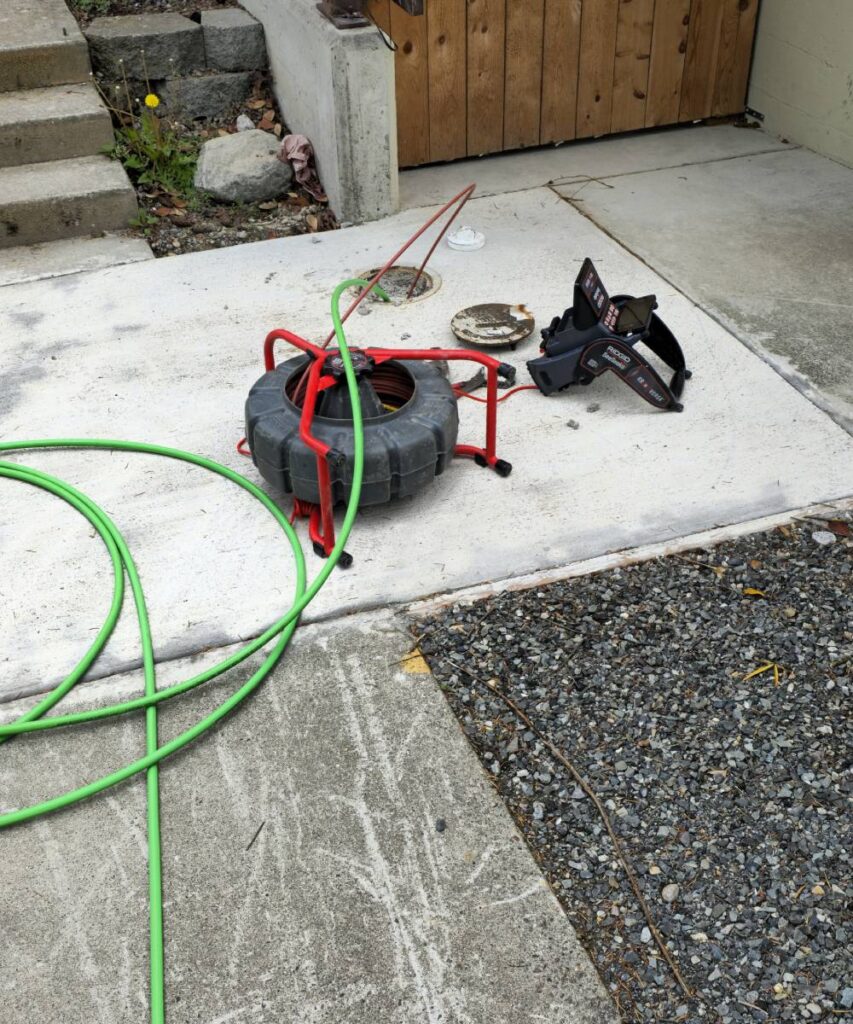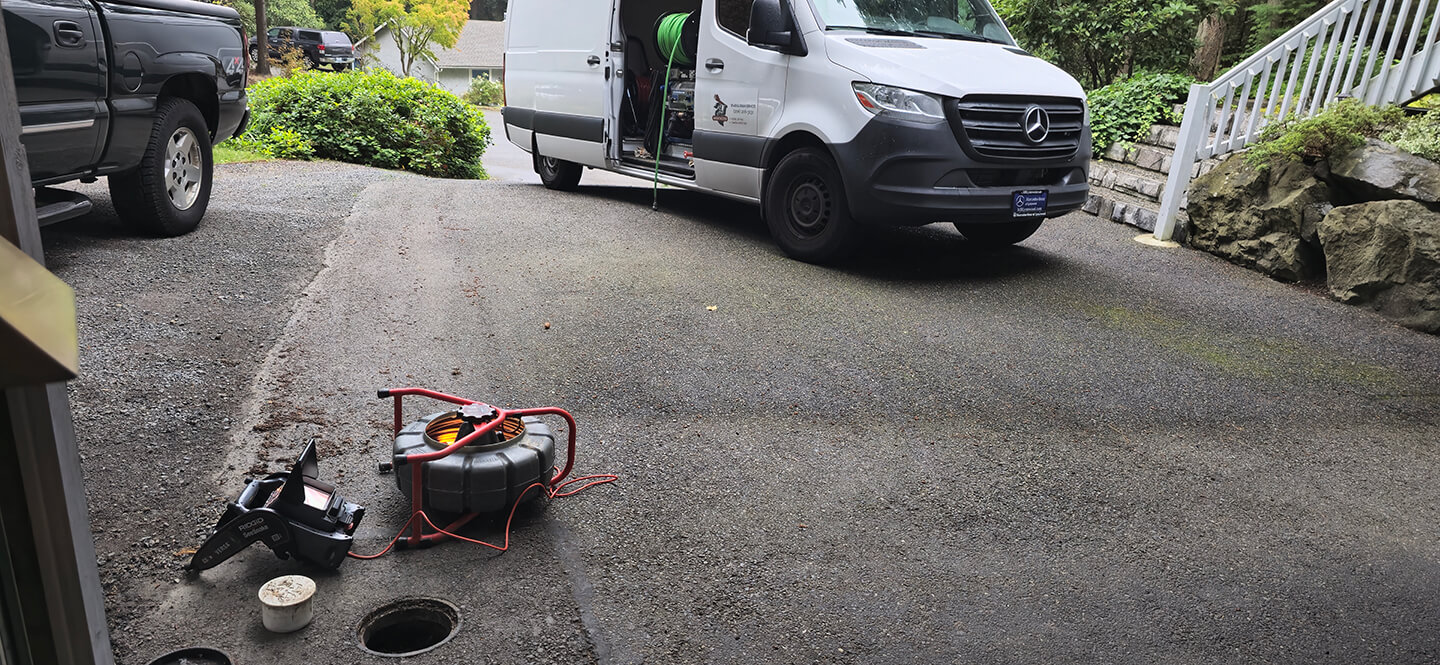Seattle’s iconic rainy weather and lush greenery come with a hidden downside: underground sewer systems that face unique stresses from moisture, shifting clay soils, and invasive tree roots. Many homeowners only discover severe pipe damage during a crisis, like a backyard sinkhole or sewage backup, leading to thousands in emergency repairs. But what if you could peek inside those “hidden pipes” without digging up your yard?
Sewer camera inspections—also known as video pipe inspections—offer a high-tech solution, using miniature cameras to reveal cracks, blockages, and collapses before they escalate. As a plumbing expert with over two decades in Seattle’s challenging terrain, I’ve seen how these tools transform reactive fixes into proactive maintenance. In this guide, we’ll dive deep into what sewer cameras uncover, why they’re essential for Seattle’s aging infrastructure, and how they support long-term home integrity. Whether you’re buying a historic Queen Anne home or maintaining a modern Bellevue property, understanding these inspections empowers you to protect your investment.
Understanding Seattle’s Sewer Systems
The Role of Side Sewers in Seattle Homes
Seattle’s sewer infrastructure reflects the city’s evolution from its 19th-century logging roots to a bustling metropolis. Most residential side sewers—the lines connecting your home to the public main—are made of clay, concrete, or cast iron, materials installed decades ago that now contend with modern demands.
Your side sewer handles all wastewater from toilets, sinks, and drains, typically running 50–100 feet from your foundation to the street main. In Seattle, these lines are the homeowner’s responsibility up to the property line, per Seattle Public Utilities guidelines. Unlike newer cities, Seattle’s systems often combine stormwater and sewage, amplifying strain during heavy downpours.
Why Seattle Pipes Face Unique Challenges
The region’s glacial till soils shift with seasonal rains, causing pipes to sag or offset. Evergreen trees, like madronas and maples, send roots questing for moisture straight into joints. Add in the acidic rainwater that erodes concrete, and it’s no wonder 40% of Seattle homes over 30 years old harbor undetected issues. Without visibility, small vulnerabilities snowball into backups that contaminate basements or erode foundations.
What Are Sewer Camera Inspections?
A sewer camera inspection is a diagnostic procedure using a compact, waterproof camera on a flexible cable to visually explore your pipes. Equipped with LED lights and high-definition lenses, these devices transmit real-time footage to a technician’s monitor, providing a crystal-clear view of interiors that are otherwise invisible.
Unlike traditional snaking, which only clears clogs, cameras diagnose without disruption. Modern units include transmitters for depth location and can navigate bends up to 90 degrees, inspecting lines from 2- to 12-inch diameters. For Seattle’s variable pipe materials, this tech is invaluable, spotting issues in clay tiles that might mimic solid lines from the surface.
The Sewer Camera Inspection Process Step-by-Step
Wondering what happens during a typical inspection? The process is efficient, non-invasive, and takes 30–60 minutes for most homes. Here’s a breakdown:
Preparation and Access
Technicians start by locating a cleanout—a capped access point near your foundation, often in the basement or yard. If buried, they use a probe to find it without major digging. Running water through fixtures flushes debris, lubricating the line for smooth camera travel.
Inserting and Navigating the Camera
The camera head, about the size of a lightbulb, attaches to a 100–200-foot cable reel. Inserted via the cleanout, it’s slowly advanced while the technician monitors footage. A built-in odometer tracks distance, and a sonde signal pinpoints the camera’s ground position for precise issue mapping.
Real-Time Analysis and Documentation
As the camera snakes through, experts note anomalies like buildup or fractures. Footage is recorded in HD, often with timestamps. Upon retrieval, a detailed report—including stills, video clips, and recommendations—is provided, sometimes via secure digital link.
This methodical approach ensures accuracy, minimizing false positives from surface symptoms alone.

Common Hidden Problems Sewer Cameras Detect in Seattle
Sewer cameras excel at unveiling “silent killers” in pipes. In Seattle, where 60% of homes predate 1970, these revelations often prevent disasters. Here’s what they commonly expose:
Tree Root Intrusions
Seattle’s tree canopy is a beauty—and a beast. Roots infiltrate joints seeking water, forming hairy blockages or bulging pipe walls. Cameras show fibrous networks that snaking misses, explaining recurrent clogs in fall when roots expand.
Cracks, Breaks, and Collapses
Clay pipes crack from soil settlement; concrete erodes from acidic runoff. Inspections reveal hairline fractures widening into offsets (misaligned sections) or full collapses, where soil voids form potential sinkholes—a real risk in Queen Anne’s steep slopes.
Buildup and Blockages
Grease, scale, and debris accumulate in low spots (bellies), slowing flow. In Seattle’s combined systems, autumn leaves exacerbate this. Cameras differentiate minor grease from debris dams, guiding targeted hydro-jetting.
Corrosion and Material Degradation
Cast iron rusts; orange foxing signals failure. Vitrified clay shows pitting from hydrogen sulfide gases. Early detection via camera allows trenchless relining, extending life by decades without excavation.
Benefits of Sewer Camera Inspections for Seattle Homeowners
Cost Savings and Prevention
Spotting a small root intrusion early can prevent major pipe failure later. Non-invasive technology cuts diagnostic time dramatically, avoiding exploratory digs in Seattle’s rocky yards.
Environmental and Property Protection
Early fixes prevent sewage leaks contaminating Puget Sound tributaries. Minimal disruption preserves landscaping, crucial in eco-conscious neighborhoods like Fremont.
Peace of Mind for Buyers and Sellers
Pre-sale inspections disclose issues, smoothing transactions. Video evidence supports insurance claims, reducing liability in Seattle’s competitive market.
Long-Term System Health
Regular scoping (every 2–5 years) extends pipe life, integrating with Seattle’s sustainability goals like greywater recycling.
When to Schedule a Sewer Camera Inspection
Signs of Trouble
Recurring slow drains, sewage odors, or lush grass over lines signal issues. Post-rain backups? Time for a scope.
Routine and Milestone Checks
Inspect homes over 25 years old biennially. Essential during real estate deals or after tree removals near lines.
Seasonal Considerations in Seattle
Fall inspections catch root growth; spring checks address winter shifts for ongoing system health.
Preventing Sewer Issues: Tips for Seattle Residents
Armed with knowledge, prevention is straightforward:
- Plant Wisely: Avoid deep-rooted trees within 10 feet of lines; opt for shallow-rooted natives like salal.
- Maintain Gutters: Clear leaves to reduce debris entry; install downspout extensions.
- Flush Smart: Use enzyme cleaners monthly; avoid grease and wipes.
- Schedule Annual Pro Checks: Combine with camera scopes for comprehensive care.
- Upgrade Materials: Consider epoxy lining for vulnerable clay sections.
These habits, paired with inspections, fortify your system against Seattle’s elements.
Conclusion
Seattle’s hidden pipes hold secrets that can sabotage your home’s foundation—until a sewer camera brings them to light. From root invasions thriving in our wet soils to collapses lurking beneath rainy lawns, these inspections demystify underground threats, saving time, money, and stress. As we’ve explored, the process is simple, the benefits profound, and the timing critical for our city’s unique environment.
Ready to uncover what’s beneath? For expert sewer camera inspections tailored to Seattle’s challenges, contact KnightRooter today. With decades of local experience, our certified technicians use state-of-the-art HD cameras to deliver precise diagnostics and customized solutions—ensuring your pipes flow freely for years to come.
Explore More Resources
For more information on sewer line maintenance and repair, visit our service pages:
- Camera Inspection Everett
- Camera Inspection Edmonds
- Camera Inspection Seattle
- Camera Inspection bothell
- Camera Inspection Kirkland
- Camera Inspection Lynnwood
- Camera Inspection Woodinville
- Camera Inspection Snohomish
- Camera Inspection Bellevue
AFQ
Is a sewer camera inspection invasive?
No—it’s trenchless, using existing cleanouts with zero landscaping disruption.
How often should I get one?
Every 2–5 years for older homes, or after symptoms like slow drains.
Can it find leaks?
Yes, for visible cracks or offsets causing backups; pair with acoustic detection for pinholes.
What’s the difference between scoping and snaking?
Snaking clears clogs; scoping diagnoses root causes without removal.
For professional and fast drain cleaning Bothell, drain cleaning Seattle, and drain cleaning Bellevue, contact KnightRooter. Our team is ready to provide the best solutions for your drain issues.





No comment yet, add your voice below!